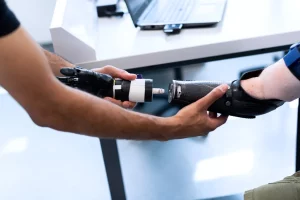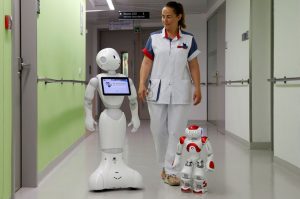During the past few years, advanced robots has become a major force in many fields, changing how businesses work and making them more efficient and productive. Adding advanced robotic systems is changing workflows, making processes more efficient, and opening up new opportunities in many fields, from manufacturing to healthcare to transportation. This piece goes into detail about how advanced robotics has changed different fields. It shows key benefits, important case studies, and examples that show how they’ve made a big difference.
Learning About Advanced Robotics

When robots are very smart and have artificial intelligence (AI), machine learning, and sensing technologies built in, this is called advanced robotics. It is possible for these robots to do complicated jobs with accuracy and flexibility, which makes them useful in many situations. Advanced robotics can work in changing environments, interact with people, and make choices based on real-time data. Traditional robots were often limited to doing the same things over and over again in controlled environments.
Benefits of Advanced Robotics
- Increased Efficiency and Productivity
Advanced robotics can operate continuously without fatigue, leading to significant increases in efficiency. They can perform tasks faster and with greater accuracy than human workers, reducing cycle times and enhancing overall productivity. - Cost Reduction
Although the initial investment in advanced robotic systems can be substantial, they often lead to long-term cost savings. By reducing labor costs, minimizing errors, and optimizing resource allocation, businesses can achieve a quicker return on investment (ROI). - Improved Safety
Robotics can take on dangerous tasks, reducing the risk of workplace accidents. In industries such as construction and manufacturing, robots can perform hazardous jobs, thereby protecting human workers from potential harm. - Enhanced Quality and Consistency
Robots are designed to perform tasks with high precision, which improves product quality and consistency. This is particularly beneficial in industries where even minor variations can lead to defects. - Flexibility and Scalability
Advanced robotics can be programmed or trained to perform various tasks, allowing businesses to adapt quickly to changing demands. This flexibility enables companies to scale operations efficiently, responding to market trends without extensive downtime.
Case Studies of Advanced Robotics in Action
Making things with ABB robots
ABB, a world leader in industrial automation, was one of the first companies to use advanced robotics in production. One case that stands out is the work they did with a big automaker to automate assembly lines. The manufacturer greatly increased the efficiency of its output by using ABB’s robotic arms that are equipped with machine vision and AI. The robots were able to do very precise jobs like welding, painting, and putting together parts, which cut down on the time needed to make each vehicle. Because of this, the plant’s output went up by 30% and its prices went down by 25%.
Healthcare Robotics at Intuitive Surgical

The da Vinci Surgical System from Intuitive Surgical is a great example of how advanced robots is changing healthcare. Surgeons can use this robotic surgical tool to do minimally invasive surgeries with more accuracy and control. The system has robotic arms, a 3D high-definition vision system, and easy-to-use tools that let the surgeon move the instruments inside the patient more precisely and smaller with their hands.
The da Vinci system has changed surgeries like hysterectomies and prostatectomies, making healing faster and causing patients less pain after surgery. Higher patient happiness and better surgical outcomes are reported by hospitals that use the da Vinci system. This shows how important advanced robotics are in the medical field.
Precision farming and farming in general
Modern robots is a key part of making farming more productive and environmentally friendly. Robotic systems are being used for precision farming for the first time by companies like Blue River Technology. Their “See & Spray” technology uses computer vision and machine learning to find and kill specific weeds in a field. The robot only uses chemicals where they are needed, so they are not sprayed over an entire area. This cuts the amount of chemicals used by up to 90%.
Farmers who use this technology not only cut down on the costs of applying herbicides, but they also have less of an effect on the environment, which encourages farmers to use safe farming methods. This case shows how advanced robots can help solve problems in farming while also making things more efficient and long-lasting.
Examples of Advanced Robotics Applications
- Logistics and Warehousing
Companies like Amazon and Alibaba are leveraging advanced robotics in their logistics operations. Amazon’s Kiva robots, for example, navigate warehouses autonomously, transporting goods to fulfillment centers. This automation has significantly reduced the time taken to pick and pack orders, allowing for quicker delivery times. - Construction Robots
Construction firms are increasingly adopting robotics for tasks such as bricklaying and concrete pouring. Robots like the SAM (Semi-Automated Mason) can lay bricks at a rapid pace, improving the speed of construction projects while maintaining high-quality standards. - Robotic Exoskeletons in Industry
Robotic exoskeletons, such as those developed by Ekso Bionics, are being utilized in industries like manufacturing and construction to assist workers with heavy lifting. These wearable devices reduce the physical strain on employees, enhancing their productivity and reducing the risk of injury. - Service Robots in Hospitality
In the hospitality industry, robots like those from Savioke are being used to deliver room service in hotels. These service robots can navigate through hotel corridors, delivering items to guests without human intervention, improving operational efficiency and guest experience.
The Future of Advanced Robotics in Industries

The potential of advanced robotics is vast, and as technology continues to evolve, we can expect to see even greater advancements and applications. Here are some anticipated trends for the future:
- Integration with AI and Machine Learning
The synergy between advanced robotics and AI will lead to smarter systems capable of learning from their environment and improving their performance over time. This will enable robots to handle more complex tasks and make autonomous decisions. - Collaborative Robots (Cobots)
Collaborative robots, or cobots, are designed to work alongside human workers safely. The growth of cobots will facilitate greater human-robot collaboration in various industries, enhancing productivity while ensuring safety. - Customization and Personalization
As robotic technology becomes more accessible, businesses will be able to customize robotic solutions to fit their specific needs. This personalization will drive the adoption of robotics in smaller companies and diverse sectors. - Robotics in Developing Economies
Advanced robotics is expected to gain traction in developing economies, helping to address labor shortages and improve efficiency in industries such as agriculture and manufacturing. This could lead to economic growth and enhanced quality of life in these regions. - Ethical and Regulatory Considerations
As advanced robotics becomes more prevalent, ethical considerations and regulations will need to evolve. Issues such as job displacement, data privacy, and safety standards will be at the forefront of discussions around robotics in the workplace.
Challenges Facing Advanced Robotics
While advanced robotics presents numerous benefits, several challenges must be addressed:
- High Initial Investment
The cost of implementing advanced robotic systems can be a barrier for many businesses. Smaller companies may struggle to justify the initial investment, even if long-term savings are evident. - Skill Gap
The integration of robotics into industries requires a workforce skilled in operating and maintaining these systems. Companies may face challenges in finding qualified personnel, necessitating investment in training and education. - Technological Reliability
As with any technology, reliability is crucial. Businesses must ensure that their robotic systems are dependable and can operate in various conditions without frequent breakdowns. - Cybersecurity Risks
Advanced robotics systems are often connected to networks, making them vulnerable to cyberattacks. Ensuring the security of these systems is paramount to protect sensitive data and maintain operational integrity.
Conclusion
There’s no doubt that advanced robots is changing many fields and making them safer, more productive, and more efficient. Robotics has the power to change many fields, from industry and healthcare to agriculture and logistics. Many case studies and examples show this. Looking ahead to the future, the continuing addition of AI, machine learning, and collaborative systems will make robotics even more useful, opening up exciting opportunities for companies in all fields.
There are still problems, but they can only be fixed by spending money on technology, training for workers, and security measures. Only then can the full promise of advanced robotics be realized. As businesses get used to these changes, the future looks bright for a world where people and robots work together to make things better and more efficient.








